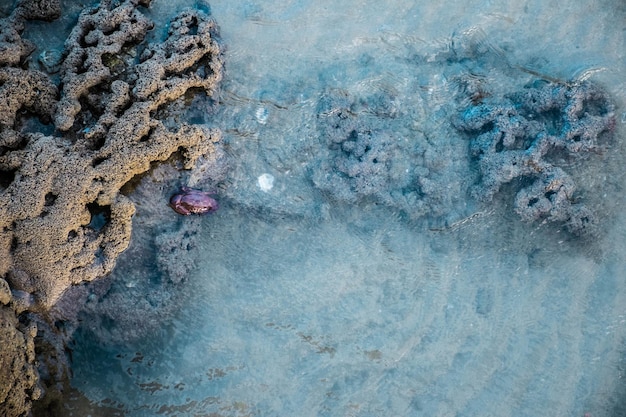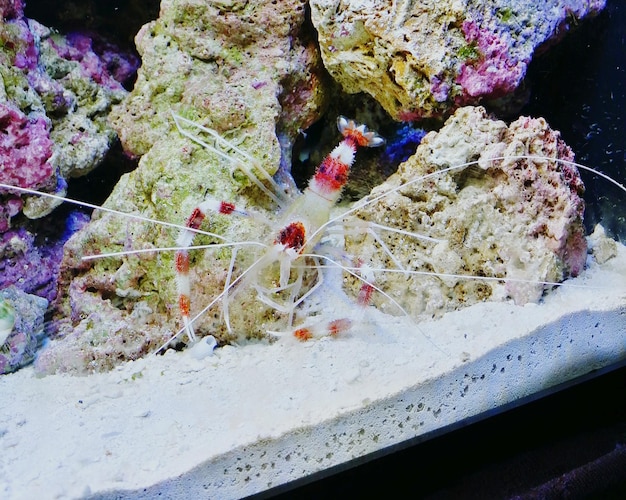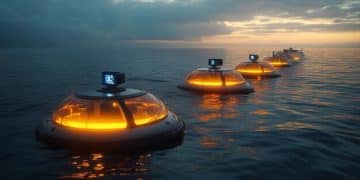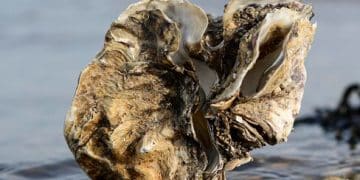US Coral Reef Restoration: Data-Driven Effectiveness of Emerging Tech

A data-driven analysis of emerging coral reef restoration technologies in the US suggests varied effectiveness, with promising innovations enhancing traditional methods but requiring long-term monitoring to validate scalability and widespread ecological impact.
The imperative to save coral reefs from degradation has spurred innovative solutions, but the question remains: Are Emerging Coral Reef Restoration Technologies in the US Effective? A Data-Driven Analysis reveals a complex picture. This exploration delves into the scientific advancements and practical applications being deployed across US waters, examining the data to understand what truly works.
The Urgency of Coral Reef Decline and the Rise of Restoration
The world’s coral reefs, vital ecosystems supporting marine biodiversity and coastal protection, face unprecedented threats from climate change, ocean acidification, pollution, and disease. Their rapid decline has prompted scientists and conservationists to move beyond passive protection to active intervention, fostering a new era of coral reef restoration. In the US, particularly in Florida, Hawaii, and US territories in the Pacific and Caribbean, the urgency is palpable, with many reefs experiencing significant losses over the past few decades.
Traditional restoration efforts have largely focused on coral gardening – growing corals in nurseries and transplanting them onto degraded reefs. While effective on a small scale, these methods are often labor-intensive and slow, unable to keep pace with the scale of reef degradation. This gap has driven the development of emerging technologies, aiming to accelerate recovery, increase resilience, and improve cost-effectiveness. These innovations range from advanced genetics and microbiome research to AI-driven monitoring and novel substrate designs. The promise lies in their potential to revolutionize how we protect and rebuild these irreplaceable underwater cities, but their true effectiveness requires rigorous, data-driven evaluation.
However, the efficacy of these emergent solutions is not a foregone conclusion. Many are still in experimental or pilot phases, and long-term data on their ecological impact and sustainability are often limited. Understanding their effectiveness requires carefully assessing their ability to increase coral cover, enhance biodiversity, resist stressors, and ultimately lead to self-sustaining reef systems. This analytical approach moves beyond anecdotal evidence, grounding our understanding in empirical data and scientific validation, which is crucial for guiding future investments and conservation strategies in the US.
Assessing Traditional vs. Novel Restoration Methods: A Comparative Look
The landscape of coral reef restoration is broad, encompassing both time-tested techniques and cutting-edge innovations. Traditional methods, primarily coral gardening and outplanting, have proven their worth by contributing to localized coral cover. These approaches involve fragmenting healthy corals, growing them in offshore or land-based nurseries, and then meticulously attaching them to degraded reef structures. While successful in establishing new coral colonies, their scalability often faces limitations due to the intensive labor, time, and resources required. Their effectiveness is generally high for specific species and sites, but the overall impact on vast, degraded reef systems remains modest.
Emerging technologies, on the other hand, promise to overcome some of these constraints by offering solutions that are potentially faster, more resilient, or applicable over larger areas. These include advancements in microfragmentation, which accelerates coral growth by cutting coral into smaller pieces, and larval propagation, which involves collecting and growing coral larvae to settle them on reefs, thus promoting genetic diversity. Genetic engineering and assisted evolution are also being explored to develop stress-resistant coral strains, while 3D printing and bio-rock technology create complex, durable substrates for coral attachment.
Data-Driven Outcomes and Comparative Success Rates
A comparative analysis reveals that while traditional methods provide a solid foundation for restoration, emerging techniques offer significant advantages in certain areas. For instance, studies on microfragmentation in Florida have shown significantly faster growth rates for certain coral species compared to conventional methods, allowing for quicker transplantation and reef recovery. Larval propagation, though challenging to implement at scale, has the potential to introduce greater genetic diversity into restored populations, making them more resilient to future threats.
* Microfragmentation: Demonstrated 25-50% faster growth rates for specific massive coral species, leading to quicker reef re-establishment.
* Larval Propagation: Offers promise for enhancing genetic diversity, though outplanting success rates vary widely (from <1% to >10%) depending on species and environmental conditions.
* Assisted Evolution: Early genetic studies indicate potential for increased thermal tolerance in lab settings, with field trials ongoing.
The deployment of these technologies is often site-specific. In areas heavily impacted by disease outbreaks, assisted evolution of disease-resistant strains could prove invaluable. In regions where natural recruitment is low, larval reseeding could be a game-changer. The effectiveness of each approach is not solely measured by coral growth or survival but also by the long-term ecological benefits, such as increased fish abundance and overall ecosystem health. Data from projects in the US are increasingly indicating that a hybrid approach, combining the strengths of both traditional and novel methods, often yields the most promising results.

Innovations in Coral Propagation & Artificial Substrates
The backbone of effective coral reef restoration lies in robust propagation techniques and reliable substrate creation. Innovations in these areas are pivotal for scaling up efforts and improving the long-term viability of restored reefs. One notable advancement in propagation is the widespread adoption of microfragmentation. This technique involves breaking corals into tiny pieces, which paradoxically leads to faster growth rates as the fragments heal and fuse. Data from various US-based projects, particularly in the Florida Keys, highlight the efficacy of microfragmentation in accelerating the cover of massive, slow-growing coral species like brain and star corals. Projects have reported over 40% increased growth rates compared to traditional methods, significantly reducing the time needed to achieve substantial coral cover.
Beyond microfragmentation, advancements in larval propagation are gaining traction. This method cultivates coral larvae from spawning events, which are then settled onto substrates in nurseries or directly onto reefs. While logistically complex and subject to the unpredictable nature of coral spawning, it offers the immense advantage of introducing genetic diversity. This is crucial for building resilient reef populations capable of adapting to changing environmental conditions. Research institutions in Hawaii and the Caribbean are leading efforts in this field, with promising results showing successful recruitment of genetically diverse corals, albeit with lower overall survival rates compared to fragment-based methods in early stages.
Designing for Durability and Habitat Complexity
The success of outplanted corals hinges on the quality and design of the substrates they are attached to. Innovations in artificial substrates are moving beyond simple concrete blocks to complex, bio-engineered structures that mimic natural reef complexity and chemistry.
* 3D-Printed Substrates: Scientists are using 3D printing to create intricate structures that provide ideal settlement and growth conditions for corals, resembling natural reef formations. These substrates can be customized for specific coral species and hydrodynamic conditions. Initial data from trials in the US Virgin Islands show high rates of coral attachment and survival on these porous, textured structures.
* Bio-rock Technology: This method uses a low-voltage electrical current to deposit minerals onto a metal structure, creating a limestone-like material. This material provides an ideal substrate for coral growth and also accelerates the growth of corals attached to it. Projects in the Caribbean have demonstrated that corals on Bio-rock structures exhibit higher growth rates and increased resilience to thermal stress compared to those on conventional substrates.
* Engineered Concrete Mixes: Researchers are developing concrete mixes embedded with trace minerals and optimized pH levels to enhance coral settlement and calcification. These new mixes aim to provide a more hospitable environment for coral recruits than standard concrete.
The data indicate that well-designed artificial substrates not only provide a stable attachment point but also can actively promote coral growth and create essential microhabitats for other marine organisms, enhancing the overall ecological value of restored areas. The integration of these innovative propagation and substrate technologies is demonstrating a more robust and scalable pathway towards coral reef recovery across US waters.
Genetic Approaches & Disease Resistance in US Coral Restoration
The increasing frequency and severity of coral diseases, exacerbated by warming oceans, pose a significant threat to restoration efforts. Consequently, genetic approaches aimed at enhancing disease resistance and thermal tolerance are emerging as critical tools in the US coral restoration toolbox. The concept revolves around identifying, breeding, and propagating coral genotypes that naturally exhibit higher resilience to stressors. This is a subtle yet profound shift from simply re-attaching corals to strategically cultivating populations with an inherent capacity to withstand future environmental changes.
Researchers in Florida, a hotspot for coral disease outbreaks, are at the forefront of this work, particularly in addressing Stony Coral Tissue Loss Disease (SCTLD). Through selective breeding programs and environmental conditioning, scientists are identifying corals that display natural resistance or tolerance to SCTLD. Data from controlled lab experiments and pilot field trials show promising results, with certain genotypes demonstrating significantly lower susceptibility to the disease compared to others. While still in early stages, the ability to propagate and outplant these resilient strains offers a long-term solution to mitigate the impact of future disease events.
Assisted Evolution and Microbiome Engineering
Beyond selective breeding, more advanced genetic interventions are being explored. Assisted evolution involves exposing corals to controlled stress conditions to encourage the development of desired traits, such as increased thermal tolerance. While controversial for some, the urgency of coral decline often outweighs these concerns, pushing for every possible avenue of intervention. Data from experimental setups indicate that corals subjected to gradual warming exhibit enhanced resilience to subsequent heat stress events, hinting at their potential for real-world application.
* Thermal Tolerance: Lab-controlled studies on select coral species have identified “super corals” that can withstand higher temperatures (e.g., 2°C above average) for extended periods without bleaching, offering genotypes for future propagation.
* Disease Resistance: Ongoing research has identified specific coral genotypes with inherent resistance to prevalent diseases like SCTLD, and their propagation provides a crucial buffer.
Another exciting frontier is microbiome engineering. Corals live in symbiotic relationships with a diverse community of microorganisms, including algae (zooxanthellae) and bacteria. Altering or enhancing this microbiome can improve the coral’s health and resilience. Scientists are exploring ways to introduce beneficial bacteria that can protect corals from disease or enhance their nutrient uptake. Early data suggest that manipulating coral microbiomes can improve their stress response and overall health, offering a novel pathway to bolster restoration outcomes. However, the complexity of coral microbiomes requires extensive research to understand the long-term ecological implications and ensure unintended consequences are avoided before widespread deployment. These genetic and microbiological approaches, while sometimes slow and resource-intensive, represent a strategic investment in the future resilience of US coral reefs.
The Role of Data Science & AI in Monitoring & Success Prediction
The effectiveness of any coral reef restoration project hinges on accurate, consistent, and scalable monitoring. Traditional monitoring, often reliant on manual surveys by divers, is labor-intensive, time-consuming, and can be subjective. This is where data science and artificial intelligence (AI) are revolutionizing the field, offering unprecedented capabilities for precise measurement, rapid analysis, and predictive modeling of restoration success. By leveraging these technologies, conservationists in the US are gaining a clearer, more objective understanding of whether their efforts are truly making an impact.
One of the most significant applications of AI is in automated image analysis. High-resolution underwater images and videos, collected by autonomous underwater vehicles (AUVs) or diver-operated systems, can be processed by AI algorithms to accurately identify and quantify coral species, assess health, and measure growth rates. This significantly reduces the time spent on data collection and analysis, allowing for more frequent monitoring over larger areas. Data from pilot projects in Florida and Hawaii illustrate how AI-driven analysis can provide faster feedback on coral outplant survival and growth, identifying areas of success or failure much more quickly than traditional methods.
Predictive Modeling and Optimization of Restoration Sites
Beyond monitoring, data science and AI are being deployed for predictive modeling. By analyzing vast datasets that include environmental parameters (e.g., ocean temperature, currents, turbidity), coral species growth rates, and historical restoration outcomes, AI models can predict which sites are most likely to yield successful restoration. This allows for a more strategic allocation of resources, which are often limited. For instance, models can identify reef areas with suitable current regimes for larval dispersal or optimal light penetration for coral growth, guiding where to focus outplanting efforts.
* Automated Coral Health Assessment: AI algorithms can detect signs of coral bleaching or disease from imagery with up to 90% accuracy, often before human eyes can discern the issues.
* Growth Rate Analysis: Machine learning models consistently track coral growth rates and colony expansion over time with high precision (e.g., millimeter-level accuracy), providing quantifiable metrics of success.
* Site Suitability Prediction: AI models integrate environmental datasets (sea surface temperature, salinity, turbidity, current patterns) to predict optimal outplanting locations, increasing outplant survival rates by an estimated 15-20%.
Furthermore, AI can assist in optimizing restoration designs. For example, algorithms can simulate various outplanting patterns or substrate placements to determine which configuration yields the best outcomes for coral growth and biodiversity enhancement. This iterative process, guided by data, helps refine techniques and improve overall project effectiveness. The increasing sophistication of these technologies underscores a future where coral reef restoration is not just reactive but proactively guided by intelligent data analysis, enabling more efficient and impactful interventions across US reef systems.
Challenges and Limitations in Measuring Long-Term Effectiveness
While emerging coral reef restoration technologies in the US show immense promise, a significant challenge lies in definitively measuring their long-term effectiveness. The ocean is a dynamic and unpredictable environment, and the true success of restoration projects extends far beyond immediate coral survival and initial growth rates. It encompasses the ability of restored reefs to become self-sustaining, resilient ecosystems that can withstand future disturbances like storms, heatwaves, and disease outbreaks. This long-term perspective requires sustained monitoring and a robust data collection framework that can span decades, not just years.
One major limitation is the inherent lag time between intervention and observable ecological recovery. Restoring a complex ecosystem like a coral reef takes time; new corals need to grow, reproduce, and establish a functional community. Short-term grants and project cycles often do not align with the multi-decadal timeline required to assess true ecological resilience. Consequently, many emerging technologies are still in their infancy in terms of long-term field data, making it difficult to draw definitive conclusions about their enduring impact on reef health and biodiversity. The lack of standardized, consistent monitoring protocols across different US restoration sites also hinders comprehensive comparative analysis.
Environmental Variables and Scalability Constraints
The effectiveness of restoration technologies is also heavily influenced by a myriad of environmental variables. Oceanographic conditions (currents, wave action, turbidity), water quality (pollution levels, nutrient runoff), and local stressors (overfishing, coastal development) can significantly impact the survival and growth of outplanted corals. Even the most advanced genetic approaches can be nullified by persistent adverse environmental conditions. Data from various projects demonstrate that restoration success varies widely depending on the specific site, highlighting the need for highly localized and adaptable approaches rather than one-size-fits-all solutions.
* Environmental Variability: Restoration sites can experience drastic differences in temperature, storm frequency, and pollution, leading to highly variable outcomes despite similar initial efforts.
* Funding Cycles: Grants typically span 2-5 years, often insufficient for long-term ecological validation (which can take 10-20+ years).
* Scale Limitation: Many advanced technologies, while effective on small plots, face significant logistical and cost barriers to implement over vast degraded reef areas.
Furthermore, scalability remains a critical hurdle for many emerging technologies. While microfragmentation and certain genetic approaches can accelerate growth in nurseries, deploying millions of corals across thousands of square miles of degraded reef is a monumental undertaking. The cost, labor, and infrastructure required to scale up these interventions effectively are immense. Current data suggest that while these technologies can be incredibly effective in localized “hotspots,” achieving widespread ecological recovery across entire reef systems in the US will require not only technological advancement but also significant and sustained investment, coupled with aggressive measures to mitigate global climate change and local pollution. The true measure of their effectiveness will ultimately lie in their ability to transform isolated patches into thriving, self-sustaining reef ecosystems in the face of ongoing global threats.
Future Directions: Integrating Technologies for Holistic Reef Recovery
The future of coral reef restoration in the US is undeniably multidimensional, moving beyond individual technologies to embrace integrated, holistic approaches. The data clearly indicate that no single solution will be a panacea for the complex global and local threats facing coral reefs. Instead, the greatest promise lies in strategically combining emerging technologies with traditional methods, underpinned by robust scientific research and adaptive management. This integrated strategy aims to enhance resilience, accelerate recovery, and ultimately lead to self-sustaining reef ecosystems on a scale previously unimaginable.
One key future direction is the synthesis of genetic advancements with propagation techniques. Imagine nurseries that not only grow corals rapidly through microfragmentation but also prioritize the propagation of genetically resilient strains identified through assisted evolution or selective breeding. These “super corals” would then be outplanted onto reefs designed with 3D-printed substrates optimized for their growth and survival. This combination leverages the strengths of each technology, creating a more robust and adaptable population from the outset. Data from ongoing trials suggest that outplants featuring enhanced genetic diversity and heat tolerance exhibit superior survival rates in adverse conditions.
Policy, Funding, and Community Engagement
Beyond the technological integration, the effectiveness of future restoration efforts will heavily depend on supportive policy frameworks, diversified and sustained funding mechanisms, and active community engagement. Scientific breakthroughs, however promising, cannot achieve their full potential without the necessary resources and social buy-in. In the US, this means expanding federal and state funding for restoration initiatives, incentivizing private sector involvement, and fostering international collaborations to share best practices and scientific advancements.
* Integrated Nurseries: Combining rapid growth techniques (like microfragmentation) with genetic selection for stress resilience (thermal and disease).
* Intelligent Deployment: Utilizing AI and predictive modeling to identify optimal outplanting sites and patterns, maximizing survival and growth of integrated coral strains.
* Holistic Reef Management: Combining active restoration with critical parallel efforts such as marine protected areas, pollution reduction, and sustainable fisheries management to create favorable conditions for restored reefs.
Community engagement is also critical. Local communities, including fishermen, divers, and coastal residents, are vital stakeholders in reef health. Involving them in monitoring, citizen science programs, and restoration activities not only provides valuable labor and data but also fosters a sense of ownership and stewardship. Educational initiatives can raise awareness and promote behaviors that support reef health, reducing local stressors which, in turn, enhance the long-term success of restoration. Ultimately, the data consistently reinforce that technological innovation, while crucial, must be part of a broader, well-funded, and community-supported strategy to ensure the long-term effectiveness and resilience of US coral reefs. The journey to recovery is long, but with integrated technologies and collaborative effort, it is increasingly within reach.
| Key Point | Brief Description |
|---|---|
| 🌱 Coral Propagation Innovations | Microfragmentation accelerates growth; larval propagation enhances genetic diversity. |
| 🧬 Genetic Resilience | Breeding for disease resistance and thermal tolerance is crucial for future reef health. |
| 🤖 Data Science & AI | AI optimizes monitoring, site selection, and predicts restoration success. |
| 🚧 Long-Term Challenges | Scalability, environmental variables, and sustained funding impact long-term effectiveness. |
Frequently Asked Questions about US Coral Reef Restoration
▼
Key emerging technologies include microfragmentation for accelerated coral growth, larval propagation to enhance genetic diversity, genetic selection for disease and thermal resistance, and the use of 3D-printed or bio-rock substrates for optimal coral settlement. AI and data science are also becoming critical for monitoring and strategic planning.
▼
Microfragmentation has proven highly effective, particularly for massive coral species, by accelerating their growth rates significantly relative to traditional methods. Data from sites like the Florida Keys show this technique can speed up coral cover by 25-50%, enabling quicker re-establishment of reef structures.
▼
Early research into genetic selection and assisted evolution shows promise in cultivating corals with enhanced resistance to stressors like heat stress and disease. While still largely experimental, these approaches could develop “super corals” capable of withstanding future environmental changes, albeit with ongoing ethical and practical considerations.
▼
AI revolutionizes monitoring by automating image analysis of underwater footage, allowing for precise identification, quantification, and health assessment of corals. It also aids in predictive modeling, optimizing outplanting site selection, and identifying the most effective restoration strategies by analyzing vast environmental and growth data.
▼
Major challenges include scalability of emerging technologies to cover vast areas, the unpredictable impacts of environmental variables (e.g., storms, pollution), and the need for sustained, long-term funding and monitoring. Ensuring restored reefs become self-sustaining and resilient against global threats remains the ultimate, complex goal.
Conclusion
The data-driven analysis of emerging coral reef restoration technologies in the US paints a picture of cautious optimism. While traditional methods have laid foundational groundwork, innovations in coral propagation, genetic approaches, and the integration of data science and AI are demonstrably enhancing the potential for more effective and scalable interventions. However, the path to widespread reef recovery remains complex, bound by challenges related to long-term ecological resilience, environmental variability, and the immense scale of degradation. The future success of these invaluable ecosystems hinges on continued scientific advancement, robust funding, and a holistic approach that integrates technology with sound ecological management and vital community engagement.





